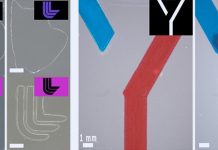
Scientists at the University of Toronto have created a new metal composite that is remarkably strong, incredibly light, and able to withstand temperatures as high as 500°C.
The material, described in Nature Communications, could open the door to major advances in aerospace design and other high-performance industries where strength, heat resistance, and low weight are essential.
The inspiration for the new material comes from something familiar: reinforced concrete.
In buildings, steel rebar forms a supportive skeleton, while the concrete around it adds structure and durability.
The research team used this same idea on a microscopic level but replaced the building materials with advanced metals.
“Thanks to modern techniques like 3D metal printing, we can now mimic the structure of reinforced concrete on a tiny scale,” says Yu Zou, senior author of the study and a professor of materials science and engineering.
“This lets us design metals with completely new combinations of strength and resilience.”
Lightweight metals are essential for aircraft because reducing weight improves fuel efficiency and performance.
Aluminum is already widely used in airplanes, but it weakens significantly at high temperatures, limiting its use in many critical parts. This new composite aims to solve that problem.
The material starts with a microscopic mesh made of titanium alloy, acting as the “rebar.” Using laser-based additive manufacturing, the team can create struts as thin as 0.2 millimeters and arrange them into any structure they want. This titanium framework provides a strong skeleton for the composite.
Next, the researchers filled the gaps in the mesh using a process called micro-casting. They created a surrounding matrix made of aluminum, silicon, magnesium, and other elements. This matrix behaves like the “cement” in concrete, holding the entire structure together.
To enhance the strength even further, the researchers added tiny particles of alumina and silicon nanoprecipitates—similar to gravel in concrete—throughout the matrix.
Once the composite was assembled, the team tested how much force it could withstand.
The results were impressive. At room temperature, the material reached yield strengths around 700 megapascals. For comparison, most aluminum alloys fall between 100 and 150 megapascals. Even more remarkable was its performance under extreme heat.
At 500°C, the composite remained extremely strong, showing a yield strength between 300 and 400 megapascals. Traditional aluminum composites soften dramatically at these temperatures, dropping to about five megapascals.
Computer simulations showed why this material stays strong when hot. Co-author Huicong Chen found that at high temperatures, it deforms through a process the team calls “enhanced twinning,” which helps preserve its structure and prevent weakening.
Although it may take time before this composite reaches commercial manufacturing, Zou says the discovery highlights the power of advanced technologies like 3D metal printing.
As these methods become more affordable, the new material could lead to lighter, stronger, and more efficient vehicles—especially in aerospace, where every gram matters.
Source: University of Toronto.



